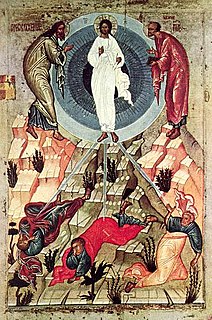
Bernard of Clairvaux, venerated as Saint Bernard, was a Burgundian abbot, and a major leader in the revitalization of Benedictine monasticism through the nascent Order of Cistercians.

Year 1115 (MCXV) was a common year starting on Friday of the Julian calendar.
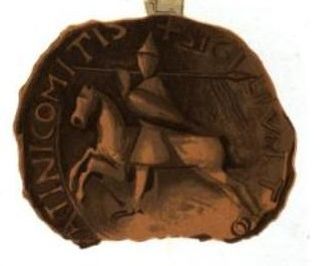
Theobald the Great (1090–1152) was count of Blois and of Chartres as Theobald IV from 1102 and was count of Champagne and of Brie as Theobald II from 1125. Theobald held Auxerre, Maligny, Ervy, Troyes, and Châteauvillain as fiefs from Duke Odo II of Burgundy.

Héloïse was a French nun, philosopher, writer, scholar, and abbess.
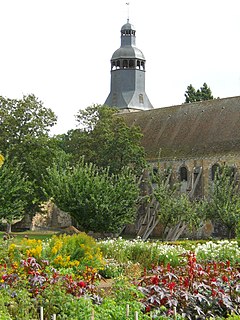
The Tironensian Order or the Order of Tiron was a medieval monastic order named after the location of the mother abbey in the woods of Tiron in Perche, some 35 miles west of Chartres in France). They were popularly called "Grey Monks" because of their grey robes, which their spiritual cousins, the monks of Savigny, also wore.

Eloisa to Abelard is a verse epistle by Alexander Pope that was published in 1717 and based on a well-known medieval story. Itself an imitation of a Latin poetic genre, its immediate fame resulted in a large number of English imitations throughout the rest of the century and other poems more loosely based on its themes thereafter. Translations of varying levels of faithfulness appeared across Europe, starting in the 1750s and reaching a peak towards the end of the 18th century and the start of the 19th. These were in the vanguard of the shift away from Classicism and towards the primacy given emotion over reason that heralded Romanticism. Artistic depictions of the poem's themes were often reproduced as prints illustrating the poem; there were also paintings in France of the women readers of the amorous correspondence between the lovers.
Porcarius, known as Saint-Porchaire or Saint-Porcaire in French, was a Benedictine abbot who governed the Abbey of Lérins, off the coast of the French Riviera, at a time when the monastery included over 500 monks.
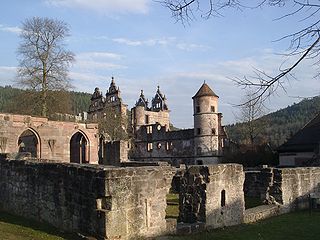
Hirsau Abbey, formerly known as Hirschau Abbey, was once one of the most important Benedictine abbeys of Germany. It is located in the Hirsau borough of Calw on the northern slopes of the Black Forest mountain range, in the present-day state of Baden-Württemberg. In the 11th and 12th century, the monastery was a centre of the Cluniac Reforms, implemented as "Hirsau Reforms" in the German lands. The complex was devastated during the War of the Palatine Succession in 1692 and not rebuilt.
Ferrières Abbey was a Benedictine monastery situated at Ferrières-en-Gâtinais in the arrondissement of Montargis, in the département of Loiret, France.

The Roman Catholic Diocese of Troyes is a diocese of the Latin Rite of the Roman Catholic Church in Troyes, France. The diocese now comprises the département of Aube. Erected in the 4th century, the diocese is currently suffragan to the Archdiocese of Reims. It was re-established in 1802 as a suffragan of the Archbishopric of Paris, when it comprised the départements of Aube and Yonne and its bishop had the titles of Troyes, Auxerre, and Châlons-sur-Marne. In 1822 the See of Châlons was created and the Bishop of Troyes lost that title. When Sens was made an archdiocese, the episcopal title of Auxerre went to it and Troyes lost also the département of Yonne, which became the Archdiocese of Sens. The Diocese of Troyes covers, besides the ancient diocesan limits, 116 parishes of the ancient Diocese of Langres and 20 belonging to the ancient diocese of Sens. On 8 December 2002, the Diocese of Troyes was returned to its ancient Metropolitan, the Archbishop of Reims.

The Abbey of Saint Victor, Paris, also known as Royal Abbey and School of Saint Victor, was an abbey near Paris, France. Its origins are connected to the decision of William of Champeaux, the Archdeacon of Paris, to retire to a small hermitage near Paris in 1108. He took on the life, vocation and observances of the Canons Regular, and his new community followed the Augustinian Rule.
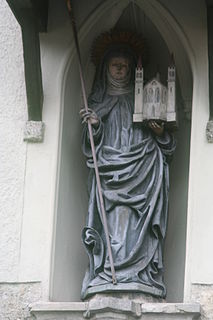
Erentrude, was a saint and abbess, born during the end of the 7th century, probably in present-day Germany or Austria. She was born into a Franconian-Merovingian royal house, and was the niece of Saint Rupert of Salzburg. She left her home country to assist Rupert in establishing religious communities in Salzburg; in about 700, he built a convent, Nonnberg Abbey, and installed her as its first abbess. She and the nuns at Nonnberg served the poor, needy, and ill, striking a balance between living as cloistered nuns and engaging in charitable works. Erentrude died on 30 June 718. Her fame for healing miracles and intercession grew after her death, and many legends have arisen throughout the centuries since her death. In 2006, Erentrude's image appeared on the Austrian Nonnberg Abbey commemorative coin. Her feast day is celebrated on 30 June.

Herrenalb Abbey is a former Cistercian monastery in the present Bad Herrenalb in Baden-Württemberg, Germany.
The Abbey of Saint-Médard de Soissons was a Benedictine monastery, at one time held to be the greatest in France.

Gloucester Abbey was a Benedictine abbey in the city of Gloucester, England. Since 1541 it has been Gloucester Cathedral.

The Abbey of St Genevieve (Abbaye-Sainte-Geneviève) was a monastery in Paris. Reportedly built by Clovis, King of the Franks in 502, it became a centre of religious scholarship in the Middle Ages. It was suppressed at the time of the French Revolution.
Kyneburga, Kyneswide and Tibba were female members of the Mercian royal family in 7th century England who were venerated as saints.

Barbeau Abbey is a former Cistercian monastery in Fontaine-le-Port in the French department of Seine-et-Marne. It was located approximately 10 kilometers northeast of Fontainebleau and 8 kilometers southeast of Melun.

Stealing Heaven is a 1988 film directed by Clive Donner and starring Derek de Lint, Kim Thomson and Denholm Elliott. It is a costume drama based on the French 12th century medieval romance of Peter Abelard and Héloïse and on a historical novel by Marion Meade. This was Donner's final theatrical film, before his death on 7 September 2010.

Peter Abelard was a medieval French scholastic philosopher, leading logician, theologian, teacher, musician, composer, and poet.
















